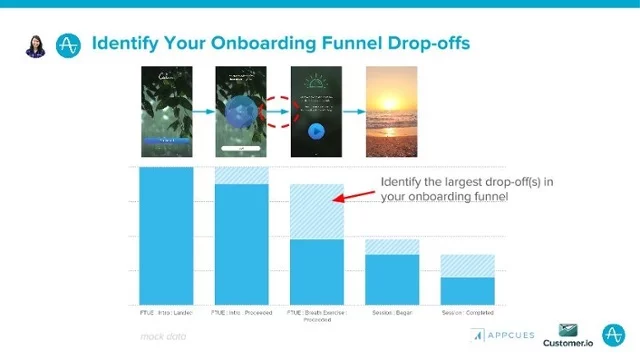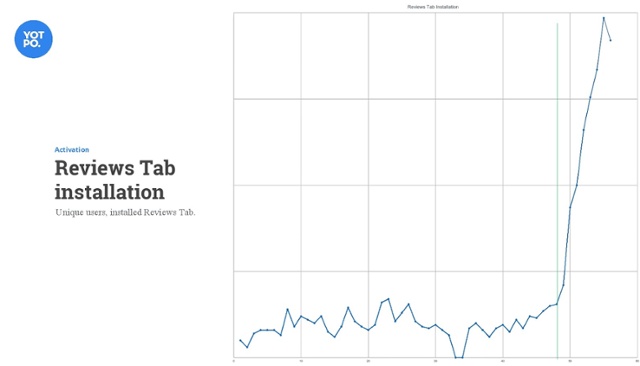Why you should be tracking your micro conversions

.png)

.png)
When you think about conversions, what comes to mind?
If you're like most product managers, you're probably thinking about the moment when a potential customer visits your site and signs up for a free trial.
Or perhaps you're daydreaming about free users plunking down their credit card info and signing up for a paid account.
You're not wrong—paying customers are the ultimate conversion goal for most SaaS companies. But the truth is, if you're only measuring success by tracking that single macro conversion, you're missing out on a treasure trove of valuable customer data and considerable opportunities for growth.
Before a user reaches that final conversion goal, they must go through dozens of smaller steps—such as configuring a key feature in your app, inviting their colleagues to collaborate, or visiting your pricing page.
These small actions are called micro conversions, and tracking and improving them over time can help boost your primary conversion rate significantly.
Let's dig in.
A micro conversion is a specific action, or set of actions, that strongly indicates that a user is progressing toward a desired goal, which is commonly called a macro conversion.
Macro conversions are directly related to the overall goal of the page or website and directly affect revenue. For example:
Micro conversions, on the other hand, come in many different forms, depending on your business type. For SaaS tools, micro conversions could be any of the following:
Bryan Eisenberg first coined the term "micro actions" way back in 2001 to describe the small steps that a customer takes on the road to conversion:
Every page on your site should focus on getting the visitor to take an action — even if that action is simply to move on to the next step in the process. Conversion rates suffer when sites fail to drive customer micro-actions and maintain momentum through the sales path. Once the path is defined and each of the micro-actions described, you can work on optimizing the most effective call to action for each step.
Essentially, if your macro conversion is at the bottom of a leaky conversion funnel, micro conversions represent opportunities to patch up holes on the user's way down. Each small improvement you make patches more holes, so more leads will make it to the bottom and your overall conversion rate and revenue will increase.
Typically, micro conversions are actions that a user takes while on a direct path to a revenue-generating conversion. But they aren't always directly related to revenue. Nielsen Norman Group breaks micro conversions into two categories:
Process milestones are actions that lead directly to the desired primary goal, or macro conversion. Identifying and monitoring process milestones will help you determine where improvements to the user experience are most needed.
Peter Clark, who leads the growth team at AdRoll, discovered that users who configured the Mailchimp integration within AdRoll were some of their highest-paying customers. But adoption of the feature was low.
Using modal windows made with Appcues, Peter's team was able to increase adoption of the Mailchimp integration by over 60%, helping customers get more value from the service—and providing a significant boost to AdRoll's revenue.

Secondary actions aren't part of a direct path toward a macro conversion, but they often build awareness and trust over time and can even predict a future macro conversion.
For example, Podia knows that live product demos are extremely effective at converting leads, so they prominently advertise their upcoming webinars directly on the front page of their site. While attending a demo may not directly lead a visitor to sign up for the service, the trust built during these demos helps convince users to sign up eventually.

Tracking micro conversions—whether they're process milestones or secondary actions—is essential. Tracking these small actions allows you to:
Your product's primary conversion rate is an aggregate of all the little conversions and small gains you're able to make. As much as you'd love to wave your magic product manager wand (you do have one, don't you?) and see a 50% gain in trial-to-paid conversions overnight, that's probably never going to happen.
What you can do, however, is focus on developing a systematic process for identifying, monitoring, and improving each micro conversion. By themselves, individual micro conversions won't have a huge impact on your bottom line. Over time, though, these marginal improvements will add up to significant—and most importantly, consistent—improvements to your overall conversion rate.
It's important to remember that there's a big difference between tracking micro conversions, and optimizing your site to increase them exclusively. Your ultimate goal should always be to track micro conversions, while optimizing for macro conversions.
It's far too easy to get sucked into spending time improving metrics that don't directly correlate to revenue, like webinar registrants or social shares. Sometimes optimizing for the wrong micro conversions can even be detrimental to your revenue. Alex Birkett, Growth Marketing manager at HubSpot, describes the “free beer” illusion in his article for ConversionXL:
Here’s a test: replace your “schedule a demo” CTA with copy that reads “Click here for free beer”
While you may very well increase your click through, you’re simply shifting the problem to the next step of the funnel. They’re still gonna drop out of the funnel (probably at a higher rate because of the message mismatch).
Optimizing for micro conversions can lead you to believe that you’re making progress, when in actuality you’re shuffling papers, shifting things around and never solving the true problems with your website.
With every change and every test, make sure you're always keeping the big-picture goals in mind.
Far too many product managers subscribe to the “spray and pray” approach to growth: They try a bunch of tactics that they heard worked for other companies, jumping from one idea to the next in hopes that one of them will be the winning ticket in the conversion lottery.
The problem with this approach is that every app and every user is different. What worked for one product might not work for yours—there's no one-size-fits-all solution.
There are dozens of reasons why your customers may not be converting. While that can feel overwhelming when you're trying to move the needle, remember that each and every roadblock to conversion is an opportunity for improvement.
In order to find the biggest opportunities for improvement, you need to break the problem into smaller, more manageable pieces. The data that you gather about your users' micro conversions will give you the insights you need to systematically improve your conversion rate over time. This strategy works for churn, and it's where the true power of tracking micro conversions comes into play.
Here's how you can get started improving your growth rate using micro conversions:
Before jumping into your product roadmap and changing things around, make sure you and your team are clear on what it is you're solving for. The key metrics you select might differ based on the kind of business you're running, but most SaaS companies will want to optimize for either free-trial sign-ups or free-to-paid conversions.
Be sure to set a specific, measurable goal and gain a clear understanding of what you're working to achieve—this will help ensure that each improvement you make is focused on the same goal and will give you a fixed end point for the process.
For example:
Once you've set your target, the next step is to identify the most important actions your users take on the path to reaching that goal. This might require some digging—talking to existing customers and your sales and support teams can help uncover the key actions that come before a primary conversion.
In our example, the main goal is to improve free-to-paid conversions by 50%. Given this objective, you might choose to monitor the following micro conversions:
Try to guess which micro conversions this dashboard for the animated video creation tool Vyond is optimized for:

The most obvious CTA is to “Make a Video.” This is because Vyond knows that once trial users have created their first video and seen the power of the product, they're much more likely to convert. They also have a secondary CTA on the page for viewing the plans and pricing page, which gives users a quick path to upgrade once they're ready.
As you identify relevant micro conversions, you may find that certain micro conversions have a bigger impact on the likelihood of a user upgrading to a paid account. Chargebee uses an action-based scoring system, similar to lead scoring, to rank each user's likelihood of conversion; this scoring system helped them identify and prioritize the product improvements that would have the greatest impact, leading to an 87% increase in overall trial-to-paid conversions.
Once you've figured out which micro conversions you should be monitoring, you'll need to configure tracking. At the least, you should be tracking which users are performing each action so you can measure your progress over time.
There are hundreds of different tools and methods for setting up in-app monitoring, but Amplitude is a great product analytics tool built specifically for SaaS companies. Setting up tracking using Amplitude is a little involved, and unless you're technically inclined (and well-trusted by your devs), you'll most likely need some support from your development team to get it up and running. But once it's set up, Amplitude's analytics platform makes it easy to track different micro conversions within your product.

If you're looking for more details on tracking micro conversions using Amplitude, here's a handy guide we wrote on how to set up Amplitude to measure the success of your onboarding flow. Most of the steps in the guide can be applied to tracking either retention or micro conversions.
Once you've started tracking how each micro conversion gets you closer to your overall goal, it's time to turn that data into a workable hypothesis.
Remember that developing a hypothesis does not mean just jumping in and making changes that you think will work. After all, you can't know whether your improvements will actually bring you closer to your overall goal until you've made the change and measured the outcome.
Treating each change as a hypothesis also helps you prioritize your ideas, based on the following criteria:
Once you've got a list of prioritized ideas, the fun part begins!
Begin by focusing your efforts on changes that are low-impact, low-effort, and have a high probability of success. These are changes that can be carried out quickly and will yield results within only a short time. While those results might be small, they'll rapidly add up to significant improvements.
With each change, it's critical to measure the impact not just on the overall trial-to-paid conversion rate but also on the micro conversion being tested. Measuring the impact on each micro conversion helps you obtain results faster—and with higher confidence—than you would solely tracking the overall macro impact.
When looking for ways to increase revenue, Yotpo's growth team realized that activating their users—getting them to see the value provided by the product—was their most important goal. Collecting micro conversion data from within their tool quickly uncovered a problem: After installing Yotpo, users would land on the admin page, and they didn't know what to do next.
Using Appcues, Yotpo launched a new onboarding flow that boosted their onboarding completion rates (their micro conversion) to over 70% and eventually contributed to a massive increase in two-week new-user retention of over 60%. By taking the time to collect data and build a hypothesis, Yotpo's relatively small change to their onboarding process yielded outsized results for the company's growth.

Every small change can give you actionable information on how to move closer to your overall target goal:
Measuring micro conversions is important—but optimizing for micro conversions is a little more complex.
Every customer journey is different and few (if any) are linear. Micro conversions give you the necessary insights needed to break down each journey into more manageable steps that can be prioritized, measured, and tested. While each test and experiment you do may only have a small impact on their own, over time these changes will add up to significant growth.
At the same time, it's important not to get caught up in the weeds. Focusing too narrowly on small optimizations, without keeping the big picture in mind, can negatively affect your overall growth or push the problem further down the funnel. Remember, every increase in a micro conversion doesn't necessarily correlate to an increase in conversions.
The most important takeaway here is that tracking micro conversions is important, and when done right it can help you grow your company and create better product experiences for your users. But make sure you don't lose sight of the larger goal. After all, if the action you're optimizing doesn't move the needle, then you might as well keep playing the conversion lottery.